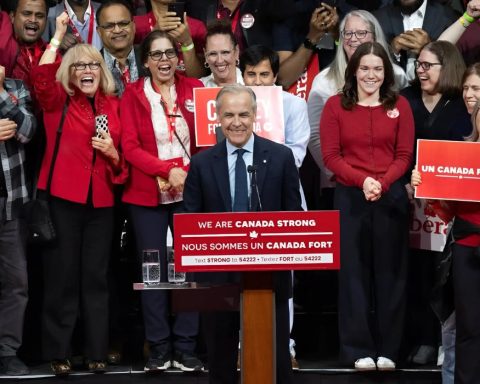If companies want to do big business with the Canadian government going forward, they’ll need to prove how green they are.
The federal government is pursuing new policies on procurement and low-carbon investment standards aimed at boosting the business prospects for companies committed to net-zero climate plans.
At the GLOBExCHANGE conference, Treasury Board President Mona Fortier and Environment Minister Steven Guilbeault announced that companies wanting to supply the federal government on contracts worth more than $25 million will need to comply with new climate change requirements.
Fortier said the procurement measure is part of a greening-government initiative, noting that Ottawa is one of the largest customers for goods and services in the country, with more than 30,000 buildings and 40,000 vehicles.
“All federal suppliers in procurements over $25 million will need to measure and disclose their [greenhouse gases] and set science-based targets” consistent with net-zero by 2050, Fortier said Tuesday.
The new measure takes effect on April 1. It will require suppliers to participate in a federal program that tracks and verifies private sector climate plans or, alternatively, in some internationally recognized equivalent program.
Guilbeault said the green procurement policy is part of a suite of measures aimed at improving the business case for companies to pursue net-zero targets and invest in climate-friendly operations.
“Climate changes means business,” the environment minister told a GLOBExChange audience. “We are on the cusp of an economic boom driven by environmental necessity.”
Guilbeault said one tool that would encourage clean investment is a transition taxonomy, or framework, that spells out which activities and projects would be seen as consistent with an eventual net-zero target and the goal of limiting global warming to 1.5°C.
The federally appointed Sustainable Finance Action Council (SFAC) has submitted a report to the Department of Finance that lays out the key recommendations for the establishment of a transition taxonomy. The government is expected to release that report in the coming days.
The taxonomy will be used as a benchmark for banks, pension funds and other financial institutions that have their own climate targets and want to align their lending and investment with a net-zero target for 2050. Inclusion in such a taxonomy could lower the cost of borrowing for capital-intensive emission-reduction projects.
Based on leaked copies, environmental groups have condemned the SFAC report because it would include investments in projects such as carbon capture and storage at oil sands plants as well as new blue hydrogen facilities that use natural gas as a feedstock but capture the carbon emissions.
The oil and gas sector accounts for 26% of Canada’s GHG emissions and says it’s exploring several strategies that would reduce emissions from operations, although none of those efforts account for the GHGs’ release when the fuel is consumed.
SFAC chair Kathy Bardswick said it is vital that Canada pursue a transition plan that reflects our current economy and the existing profile of emitters while still being consistent with the goal of limiting the current increase in average global temperatures to 1.5°C.
“We have to be able to move through a transition that makes sense,” Bardswick said at the GLOBExCHANGE conference. “But we need to ensure it is scientifically based.”
She said there is still considerable work to be done to determine specifically what projects would qualify as transition.
A European green taxonomy
The European Union has produced a green taxonomy that mostly excludes fossil fuel projects from the sustainability label, though it controversially includes some natural gas uses and nuclear as “sustainable” investments. The Canadian sustainable finance council comprises 25 institutions, including banks, pension funds, insurance companies and credit unions.
Environmental groups complain that the group is rife with conflicts of interest in setting green investment standards for themselves, given their considerable reliance on oil and gas business.
“The process is as concerning as the product; it seems pretty unfit for a functioning democracy,” says Julie Segal, a senior manager with Environmental Defence. She says the inclusion of oil and gas projects in a transition framework would amount to greenwashing for an unsustainable source of energy.
At the conference, Bardswick said the taxonomy would not be set in stone but would be reviewed and revamped on a regular basis, given that some investments that would be seen as “transitional” in 2023 would not be considered as such in 2030 or 2035.
“If it is transitional, it won’t get us where we need to be but will significantly contribute to getting us closer,” she said.
Meanwhile, financial institutions will face increasing regulations to disclose their climate-related risks and ensure they remain solvent even under scenarios in which the world fails to meet its 1.5°C target.
The Office of the Superintendent of Financial Institutions (OSFI) will be releasing further guidelines in the first half of this year that will require federally regulated banks, insurance companies and pension plans to disclose their climate-related financial risks and account for how they intend to manage them.
OSFI superintendent Peter Routledge said there is no question that “climate change is a clear and present danger to financial sector resilience.”
He said federally regulated companies will have to produce “credible and prudent climate transition plans” that include how the issue is being managed at the board and executive level; how the institution will measure and disclose risks; and the use of scenario testing to ensure the institutions can withstand both the physical and the policy risks posed by climate change.
However, OSFI does not intend to regulate the banks’ own lending and investment practices to ensure they are consistent with 1.5°C scenarios, Routledge said. Legislation introduced in the Senate by Senator Rosa Galvez would force OSFI to consider the banks’ contribution to climate change as well as the impact the extreme weather and technological change will have on them.
The process is as concerning as the product; it seems pretty unfit for a functioning democracy.
-Julie Segal, a senior manager with Environmental Defence.
Routledge said OSFI’s role is to ensure the resilience of the financial institutions and it would be overstepping that mandate to regulate their lending and investment policies. Canada’s biggest banks are members of the Glasgow Financial Alliance for Net Zero and have voluntarily committed under that organization to align their business practices with international climate goals.
The United Nations–affiliated Principles for Responsible Investment (PRI) says Canada lacks adequate rules around investment in the net-zero transition. In a report released in February, PRI urged federal regulators to provide clear guidance on how investors should go about incorporating sustainability factors into their decision-making, and how they should report on their progress toward sustainability goals.
Ottawa is moving on a number of fronts to implement the emissions-reduction plan that Guilbeault released a year ago. However, it is now under pressure to ramp up that effort to compete with U.S. clean energy incentives offered under the Inflation Reduction Act passed last year.
The Canadian Climate Institute calculates there is a shortfall of $115 billion a year in the amount of capital being invested in this country to meet our climate commitments.
Clearly, government alone cannot finance the transition to net-zero emissions, but it will require an array of carrots and sticks for the private sector to close that gap.





